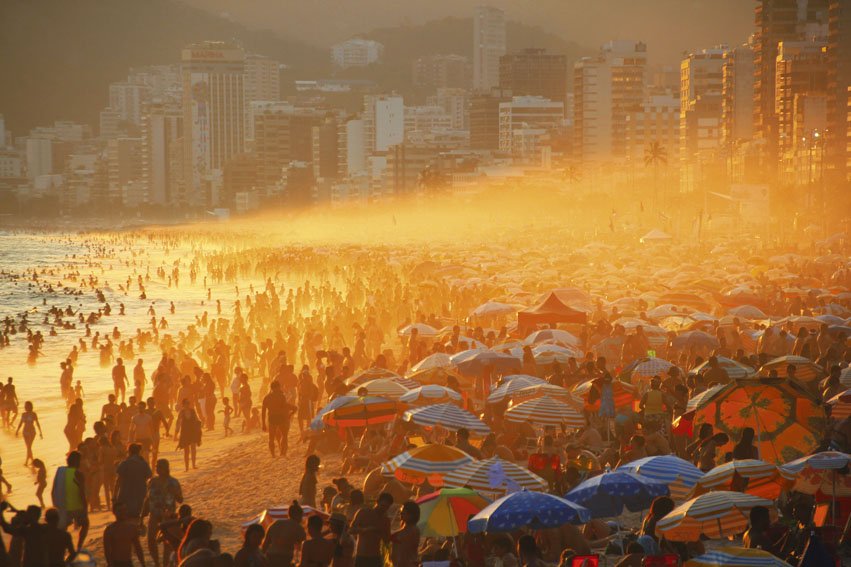
The Beach: The Real Olympic Stadium in Río de Janeiro
Text and Photos: Anna Veciana, Joan Royo
On August 5th, the best athletes in the world will file into Maracaná Stadium, saluting the Olympic flame and dreaming of glory. But in Rio de Janeiro, an irreverent, spontaneous, and creative city like few others, the sports that are most popular with the natives bear little relation to the superhuman feats of Usain Bolt and his fellow Olympians. The sports most loved by residents of the “Marvelous City” are local inventions that can be identified by their common birth on the beach. Copacabana will host beach volleyball and the triathlon during the upcoming Olympic Games. While Rio residents long ago discovered that they could do more on the beach than bask in the broiling sun, the Games will transform the world’s most famous stretch of sand into a sports arena par excellence.
No one questions the position of soccer as the king of sports in Brazil, but beach volleyball gives it a run for its money. The marriage of these two sports in the 1960s gave birth to futevolei (footvolley). Just like capoeira, another symbol of Brazilian identity, this sport emerged as a challenge to authority. Futevolei was a way of circumventing the prohibition on playing soccer on the beach. The story has it that in 1965, Octavio Moraes, better known as Tatá, a former player with the Botafogo soccer club and a regular on Copacabana beach, decided to make use of beach volleyball nets to disguise his favorite sport.
The rules are simple: two teams, one on each side of the net, try to win points. The most important rule is that players can touch the ball with any part of their bodies except their arms and hands, just like in soccer. Leonardo Fialho, better known as Leo Tubarão, fell in love with this sport sixteen years ago on Flamengo beach and made a career out of it. “Now I give classes to twenty-four students. There is a real passion for it. I would guess that in Rio some 30,000 people play futevolei,” says Leo, who points out that the sport’s main advantage is that it is played on the sand, which makes it a more energetic form of exercise.

Another typical Rio sport is frescobol. Other people might see frescobol as just batting a ball around with rackets, but Rio natives claim this sport as their own. The goal is to keep the ball in the air as long as possible. It is said to have been invented on Copacabana beach after the end of the Second World War, around 1945 or 1946. At first it was simply a variant of tennis on the beach, but everything changed in 1950 when architect Caio Rubens Romero Lyra, a resident of Bulhões de Carvalho Street, had an idea: tired of sacrificing his tennis rackets to the salt, he asked a carpenter friend to make him a few wooden paddles. Frescobol was born.
Since then, this sport has been an integral part of the memories of many Rio residents, like 51-year-old Antonio Ferreira da Silva Filho, who remembers a time before videogames, when childhood was spent playing outside. “In the beginning we were not well received, since people said we were bothering others with our games near the water’s edge. When I was young, I remember the police showing up and taking away our rackets; we had to run and dive into the sea in order to hang onto our rackets,” he recalls with amusement. That was a long time ago, and frescobol has now secured its status as a sport. To avoid bothering other beachgoers, certain zones have been set aside for the game, and the participants accept the city rule that they can play along the water’s edge only after dusk.

Ferreira, head of the Brazilian Frescobol Association, appreciates the camaraderie on the beach and stresses that this is a sport where cooperation is key: “It is the only sport where the person on the other side is a partner instead of an adversary. Other sports are all about winning; here we help each other. This philosophy of frescobol is what appeals to me most; besides, this is a healthy obsession. It forces you to go to the beach everyday!” Ferreira knows he is lucky to live in a city where he can go to work wearing a bathing suit under his clothes and carry a racket in his bag, so that he can head out to relieve stress by playing on the beach at the end of the work day. “To me, this is the quintessence of Rio de Janeiro. We cannot live without the beach. Frescobol is pure carioquice (Rio lifestyle).” It is not surprising that the authorities included the game on the city’s list of Intangible Cultural Heritage in honor of Rio’s 450th anniversary. Antonio is proud of the achievement and half jokingly predicts that frescobol will be a future Olympic sport.
Futevolei and frescobol have evolved, the rules have been perfected over time, and federations have been organized in Brazil and other countries, but there is yet another beach game that has resisted any attempt at codification, since spontaneity is its very essence. Altinho is the most casual of all of the decidedly informal Rio sports. The game is played by small groups of friends whose sole objective is to keep a ball from touching the ground. In places like Posto 10 on Ipanema beach, so many players gather on weekend afternoons that it is nearly impossible to walk along the beach for fear of getting bashed by a ball.

Sports and the body beautiful are the objects of a devotion that is palpable everywhere in the city. At dusk, Rio beaches become vast sports grounds where people cycle, skate, slackline (balancing on a low-hung, flexible line), race, play soccer and volleyball, and engage in stand-up paddle boarding, rowing, and surfing; some gyms even bring their weights and gear out to the sand. After an interval of laughter, sunbathing, and sweating with friends, there is nothing better than relaxing with coconut water as the sun sinks into the sea against the backdrop of mountains. This is Rio’s own Mount Olympus.



